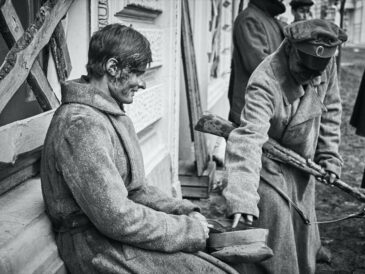On January 15, 1916, in the sunny town of Bakersfield, California, a remarkable individual named Bob Young came into the world. Little did anyone know that this young man would not only represent his country in the 1936 Olympics as a relay runner but would also go on to achieve something rather extraordinary—giving Adolf Hitler a silent but powerful gesture of disapproval.
Bob Young’s journey began in the close-knit community of Weedpatch, California, where he spent his formative years. He attended Bakersfield High School, formerly known as Kern County Union High School, which laid the foundation for his future athletic pursuits. Upon graduating, Bob embarked on his higher education journey at Bakersfield College, where fate had a pleasant surprise waiting for him—Alice, the woman who would become his lifelong partner.
While Bob’s Olympic achievements are undoubtedly noteworthy, it is essential to recognize that his most cherished accomplishment was his enduring and storybook marriage to Alice. Their love story spanned an incredible 71 years, filled with countless shared moments and cherished memories.
Bob and Alice’s romantic journey started with a single date at Bakersfield College, just before Bob’s departure for the University of California, Los Angeles (UCLA). During his time at UCLA, Bob not only excelled in academics but also displayed exceptional talent in track and field. He earned a letter of distinction in economics for three consecutive years, a testament to his well-rounded abilities.
In 1936, at the tender age of 20, Bob achieved a milestone that most athletes can only dream of—he became the youngest member of the United States Olympic Team participating in the Summer Olympics held in Berlin. Little did he know that he would be a witness to history, not just in the world of sports but in the tumultuous political landscape of the time.
A Bold Gesture in Berlin
As Bob Young and his fellow athletes competed in the 1936 Berlin Olympics, they found themselves in an environment heavily influenced by Nazi ideology. Adolf Hitler’s presence loomed large, and the traditional salute of “Heil Hitler” echoed throughout the stadium as he made his daily entrance. However, amid this atmosphere, Bob Young and his compatriots decided to make a subtle but impactful statement.
Bob’s recollections of those historic Games include a remarkable detail. He remembered, “On occasion, if the gestapo wasn’t present, we would give him the finger.” Yes, you read that correctly. Bob Young and his fellow athletes discreetly expressed their disapproval of Hitler’s regime by offering an unconventional salute. This act of defiance, while relatively small in the grand scheme of things, spoke volumes about the values they held dear.
While Bob’s relay team did achieve a significant feat by securing a silver medal in Berlin, their achievements were somewhat overshadowed by the legendary Jesse Owens. Owens, an African American athlete, stunned the world by winning four gold medals at the 1936 Olympics, defying Hitler’s misguided notions of Aryan supremacy.
It is worth noting that Bob Young’s silver medal was a testament to his dedication and talent, but the historical significance of the 1936 Olympics extended far beyond the competition itself. It was a pivotal moment in the history of sport and politics, where athletic excellence clashed with totalitarian ideologies.
Post-Olympic Life and a Twist of Fate
After his Olympic journey, Bob Young continued his education and received his degree from UCLA in 1937. However, his athletic career was soon met with an unexpected hurdle—a hamstring injury in 1938. While injuries often mark the end of an athlete’s competitive journey, for Bob, it led to a bittersweet twist of fate.
Bob’s injury opened a new chapter in his life, one that would eventually lead him back to his beloved Bakersfield. However, before we delve into that, let’s return to the heartwarming story of Bob and Alice.
After a chance meeting at the ballroom of La Granada, Bob and Alice found themselves falling in love all over again. Their reunion sparked a romance that would stand the test of time. On July 14, 1939, they exchanged vows and officially became husband and wife.
The love story of Bob and Alice would go on to include the addition of their two sons, Michael and Gary, as they embraced the joys and responsibilities of parenthood. While Bob’s professional journey took him into the world of finance and auditing, he continued to nurture his family alongside his career.
During World War II, Bob Young served his country with distinction, working for the United States Navy as an auditor and civilian administrative officer at the Terminal Island Naval Base and Shipyard in Southern California. His contributions on the home front played a vital role in supporting the war effort.
After the war, Bob and Alice returned to their roots in Bakersfield, where they would go on to build a life filled with love, laughter, and shared experiences. However, a significant adventure awaited them on the horizon—one that would lead to a legacy in the world of agriculture.
In 1955, Bob Young ventured into the world of grape farming, establishing himself as a pioneer in Paso Robles. Over the course of twenty-two years, the Young family cultivated their vineyard, making friends and selling their grapes to the renowned Paul Masson Winery.
As Bob and Alice continued to nurture their love, they were also blessed with the joys of becoming grandparents and great-grandparents. Bob’s son, Mike, fondly remembers his father as a humble and down-to-earth individual, despite his remarkable achievements.
A Life Well-Lived and a Fond Farewell
On February 3, 2011, at the age of 95, Bob Young bid farewell to the world. His legacy extended far beyond the track and field, encompassing a 71-year-long marriage, proud fatherhood, cherished grandparenthood, and the unique distinction of silently opposing Adolf Hitler.
Bob Young’s life was a testament to the extraordinary journeys that ordinary individuals can undertake. While his silver medal and world record in relay running were commendable athletic achievements, it was his act of defiance in the face of tyranny that truly set him apart. In the realm of coolness, giving Hitler the finger remains an unparalleled pinnacle of courage and conviction.
While the 1936 Olympics were a showcase of athletic excellence, they were also entangled with historical myths and misconceptions. One such myth involves Adolf Hitler’s reaction to Jesse Owens’ victories.
There is a longstanding rumor that Hitler left the Olympic Stadium when he was supposed to greet medal winners, including Jesse Owens, who had won four gold medals. Some versions of the story suggest that Hitler intentionally snubbed Owens due to his race. However, the truth reveals a different narrative.
Jesse Owens himself debunked the myth that Hitler snubbed him during the 1936 Olympics. Owens stated, “Hitler had a certain time to come to the stadium and a certain time to leave.” Owens clarified that he and Hitler exchanged waves when he passed by Hitler’s box. Additionally, Hitler later sent Owens a commemorative portrait engraved with his name.
While Hitler’s actions may not have snubbed Jesse Owens, the racial discrimination Owens faced in his own country was a stark reality. Despite his Olympic triumphs, Owens still experienced segregation and discrimination upon his return to the United States.
Hitler’s Reaction to Owens’ Success
Albert Speer, Hitler’s architect, shed light on Hitler’s reaction to Jesse Owens’ victories. Speer stated that while Hitler was pleased with many German victories, he was particularly annoyed by Owens’ remarkable achievements. Hitler’s misguided beliefs led him to view Owens and other Black athletes as physically superior but intellectually inferior.
Despite the political backdrop of the 1936 Olympics, Jesse Owens’ performance sent a powerful message of unity through sport. His victories transcended racial prejudices, bringing athletes and nations together in mutual respect and understanding.
Hitler’s remarks during the 1936 Olympics, where he spoke of the Olympic Flame as a symbol of peace and unity, took on a different meaning in the context of the impending World War II. Despite the dark shadows cast by history, the spirit of the Olympics continued to shine as a beacon of hope.
Bob Young’s act of defiance at the 1936 Olympics serves as a poignant reminder of the power of individual courage in the face of oppressive ideologies. While the world has come a long way since those tumultuous times, the lessons of history continue to resonate, urging us to stand up for what is right, even when faced with adversity.


